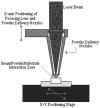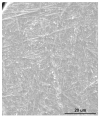Influence of porosity on mechanical properties and in vivo response of Ti6Al4V implants
- PMID: 19913643
- PMCID: PMC2830321
- DOI: 10.1016/j.actbio.2009.11.011
Influence of porosity on mechanical properties and in vivo response of Ti6Al4V implants
Abstract
Metallic biomaterials are widely used to restore the lost structure and functions of human bone. Due to the large number of joint replacements, there is a growing demand for new and improved orthopedic implants. More specifically, there is a need for novel load-bearing metallic implants with low effective modulus matching that of bone in order to reduce stress shielding and consequently increase the in vivo lifespan of the implant. In this study, we have fabricated porous Ti6Al4V alloy structures, using laser engineered net shaping (LENS), to demonstrate that advanced manufacturing techniques such as LENS can be used to fabricate low-modulus, tailored porosity implants with a wide variety of metals/alloys, where the porosity can be designed in areas based on the patient's need to enhance biological fixation and achieve long-term in vivo stability. The effective modulus of Ti6Al4V alloy structures has been tailored between 7 and 60 GPa and porous Ti alloy structures containing 23-32 vol.% porosity showed modulus equivalent to human cortical bone. In vivo behavior of porous Ti6Al4V alloy samples in male Sprague-Dawley rats for 16 weeks demonstrated a significant increase in calcium within the implants, indicating excellent biological tissue ingrowth through interconnected porosity. In vivo results also showed that total amount of porosity plays an important role in tissue ingrowth.
Copyright 2009 Acta Materialia Inc. Published by Elsevier Ltd. All rights reserved.
Figures














References
-
- Robertson DM, Pierre L, Chahal R. Preliminary observations of bone ingrowth into porous materials. J Biomed Mater Res. 1976;10:335–344. - PubMed
-
- Cameron HU, Macnab I, Pilliar RM. A porous metal system for joint replacement surgery. Int J Artif Organs. 1978;1:104–109. - PubMed
-
- Head WC, Bauk DJ, Emerson RH., Jr Titanium as the material of choice for cementless femoral components in total hip arthroplasty. Clin Orthop Relat Res. 1995;311:85–90. - PubMed
-
- Ryan Garrett, Pandit Abhay, Apatsidis Dimitrios Panagiotis. Fabrication methods of porous metals for use in orthopaedic applications. Biomaterials. 2006;27:2651–2670. - PubMed
-
- Krishna B Vamsi, Bose Susmita, Bandyopadhyay Amit. Low stiffness porous Ti structures for load-bearing implants. Acta Biomater. 2007;3:997–1006. - PubMed
Publication types
MeSH terms
Substances
Grants and funding
LinkOut - more resources
Full Text Sources
Other Literature Sources

